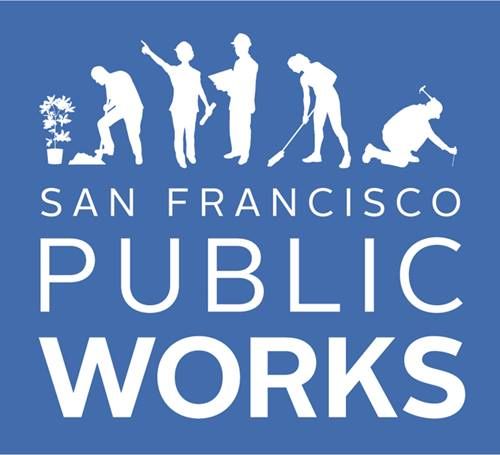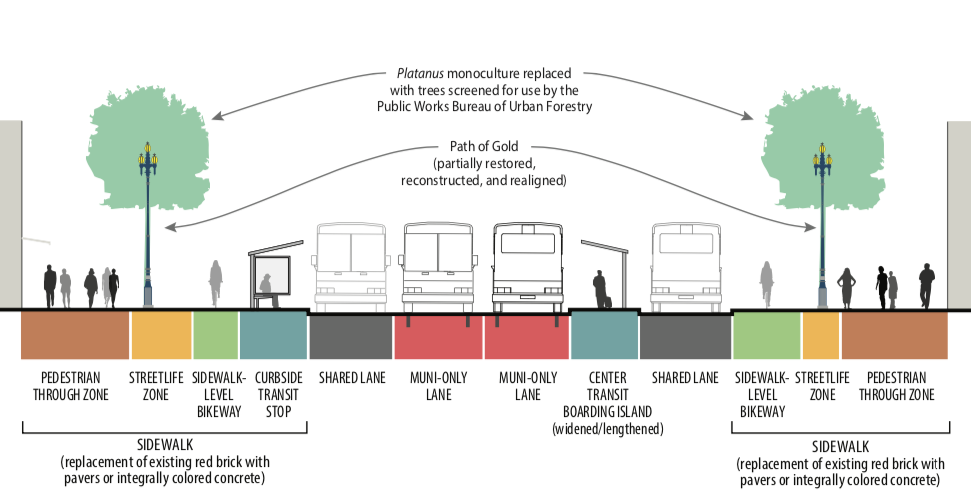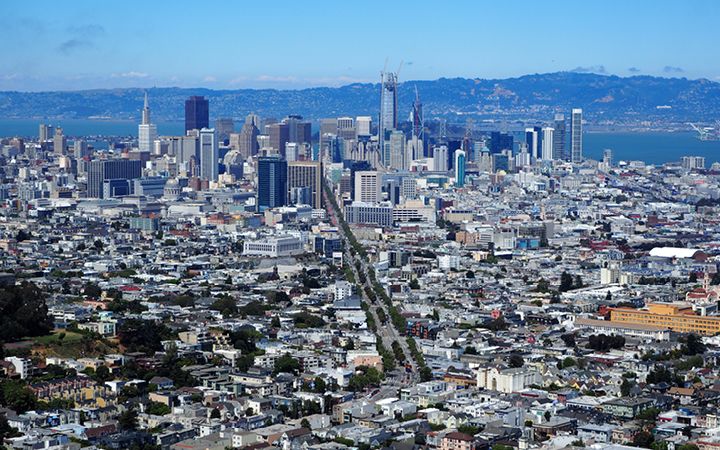Building a better main street for San Francisco
Market Street has played a pivotal role in the development of the City of San Francisco as its main transportation corridor since it was laid out in 1847. Redesigned in the late 1960s and early 1970s through a collaboration by master architects John Carl Warnecke and Mario J. Ciampi, and master landscape architect Lawrence Halprin, Market Street is a significant example of modern urban planning. Today, it remains the core of regional transit service—as well as the backbone of transit connections throughout San Francisco.
The Better Market Street project has been a complex, multi-decade effort to redefine the future of the corridor to best meet the demands of 21st-century transportation mobility options, all while also enhancing streetscape aesthetics and activating pedestrian zones for a broader array of uses. San Francisco Public Works is leading the Better Market Street project to deliver transformative transportation, streetscape, and safety improvements along 2.2 miles of Market Street between Octavia Boulevard and Steuart Street.
The primary purpose of the project is to make Market Street safer and more efficient for all modes of transportation by reducing conflicts between transit, paratransit, taxis, commercial vehicles, cyclists, and pedestrians. The secondary goals of the project are to replace infrastructure in the corridor that is reaching the end of its operational design life and to improve the accessibility of the corridor and the quality of its streetscape environment.
Challenge

Market Street is the main artery of San Francisco and the City’s Municipal Railway (Muni), with the majority of routes operating on or crossing Market Street. Market Street is among the slowest transit corridors in the system, with average speeds of approximately 5.1 mph on Market Street due to conflicts between different modes of transportation, stop spacing, and heavy passenger volumes. In addition to an average of roughly 250,000 transit boardings per day, Market Street sees substantial pedestrian use (approximately 85,000 pedestrians per weekend day on Market Street) and has experienced a significant increase in the number of bicyclists (a 183% increase between 1995 and 2015).
Market Street has multiple existing design deficiencies that contribute to a higher-than-average collision rate and pose potential hazards for all modes of transportation along the corridor. Between January 2012 and December 2016, there were 166 reported pedestrian collisions along the project corridor (137 collisions between vehicles and pedestrians, and 29 collisions between pedestrians and bicyclists). The entire length of Market Street is approximately 0.4 percent of San Francisco’s total street miles but the site of 11% of the city’s severe/fatal bicyclist injuries and 6% of the city’s severe/fatal pedestrian injuries. On average, one person is killed each year along the Market Street corridor.
Lastly, the existing brick sidewalks and transit boarding facilities along the project corridor do not comply with the Americans with Disabilities Act (ADA), posing challenges for individuals with mobility and visual impairments. Specifically, many of the 1970s-era improvements to Market Street do not meet current life safety requirements; the Better Market Street project seeks to bring these elements up to current codes.
Solution
ICF assisted the City and County of San Francisco in navigating numerous design options and alternatives that had been conceived to address design deficiencies on Market Street. We prepared environmental documentation evaluating those alternatives determined to be most viable.
ICF also conducted an extensive evaluation of cultural resources, including 146 historical resources within the Market Street corridor—consisting of historic districts, monuments, and objects—and public infrastructure systems set against a backdrop of historic buildings. ICF’s cultural resources team balanced the need to meet the project goals with Market Street’s cultural and historical significance, providing a thorough analysis of project impacts to the numerous overlapping historical resources within the corridor and developing a robust program of mitigation measures to commemorate Market Street’s important history.
The ICF team also included sub-consultants Fehr and Peers and LCW Consulting, both of whom were crucial to evaluating the impacts of proposed lane modifications on the transportation system, and to collaborating with the City to minimize the effect of such changes.

Results
The environmental process conducted under the California Environmental Quality Act (CEQA) concluded with the approval of an environmental impact report and a preferred alternative in October 2019—with no public opposition.
A separate environmental process is underway to complete an environmental assessment pursuant to the National Environmental Policy Act (NEPA). ICF has worked closely with the federal lead agency, the California Department of Transportation (Caltrans), and San Francisco Public Works to fast-track the NEPA process. This work includes collaborating with these agencies in frequent and intensive meetings and proactively anticipating and addressing issues. The NEPA process is anticipated to be completed in August 2020.
20 years
21+
$600+ million

“I wanted to express our appreciation to ICF for meeting these incredibly tight deadlines and navigating the requests, comments, and revisions from both Planning and Public Works in order to meet the ARC hearing deadlines. Thank you for all your work on this project.”
— Allison Vanderslice, CEQA cultural resources team manager, San Francisco Planning Department
